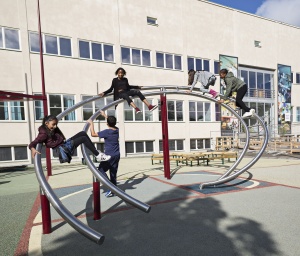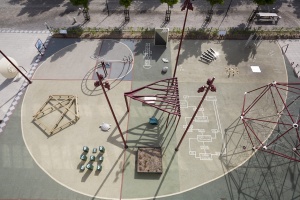Nautilus slide
| Nautilus slide | |
|---|---|

| |
| On display at | Tekniska |
| Type | Outdoors playground |
| Topics | Plane curves |
A spiral slide on display at the front yard of the Tekniska museum.
Contents
Description
A slide of steel in the shape of a nautilus shell is the central piece in Tekniska’s Mathematical Garden. This is true figuratively (it attracts attention); and literally, since the garden has the shape of a giant spiral and the slide is in the center.
Activities and user interaction
The slide has a instruction sign and there is also information in different levels about the mathematical aspects of the Nautilus shell and the connections to both Fibonacci and the golden ratio and spiral.
The purpose is to experience math with your body and to encourage curiosity for math. And visitors love it!
Mathematical background
The nautilus shell is one of the classics for describing connections between math, art, and nature. It is often said to be connected to Fibonacci and the golden ratio, although there are some misconceptions.
There are many types of spirals, often confused:
- Fibonacci spiral: Take a sequence of squares with sides corresponding to the Fibonacci sequence. Place the two 1x1 squares next to each other, and then arrange the rest of the squares by resting one side in the segment that joins the sides of two preceding squares. Finally, draw quarters of circle on each square, tracing a spiral. This construction cannot be extended inwards, only outwards following the Fibonacci sequence. This spiral is the one depicted in Tekniska's Mathematical Garden.
- Golden rectangle spiral: Take a rectangle in golden ratio. Cut a square inside. Because of the golden ratio of the rectangle, the leftover after cutting a square is another golden rectangle. Then we can repeat the process by cutting nested squares. The process can be also done outwards. Finally, draw quarters of circle on each square, tracing a spiral.
- Logarithmic spiral: Those spirals have the polar equation r = ekθ. This exponential growth appears in living organisms, populations, and other natural processes, where the growth rate depends on the size. This is the type of spiral that appears in nautilus shells (and in other spirals in nature such as galaxies).
- Golden spiral: This is just a logarithmic spiral with a certain value of k, that approximates with great accuracy a Golden rectangle spiral. When overlapping, all the points of the Golden rectangle spiral that lie on a vertex of a square, also lie on the (logarithmic) Golden spiral.
On the spirals made of arcs of circles, the curve is continuous, but its growth is not: on each quarter of a circle the radius is constant, it does not grow, and suddenly at each joint between an arc and another the radius (and thus, the curvature) changes by a step.
Actual nautiluses do not follow a circle-piecewise spiral, because they grow continuously. Real nautiluses (and snails, and other shell animals) follow a logarithmic spiral and have many different growth rates (different values of k). It is, in principle, possible to find in nature (or to imagine) a nautilus with a value of k close to that of a golden spiral. Since the golden spiral can be well approximated by a Fibonacci spiral or by a Golden rectangle spiral, one can say that those curves look like a nautilus.
See a more detailed explanation of the different spirals in Wikipedia [1]. See also [2].
History and museology
The idea of making such a slide was a result of a workshop with artists, mathematicians, teachers, and architects. The slide is completely custom-made.
